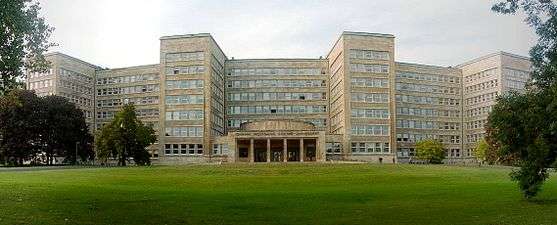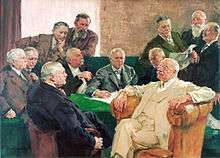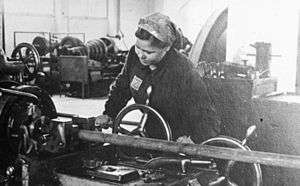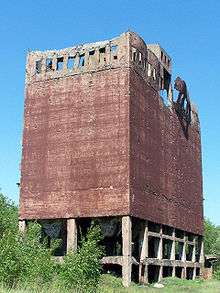IG Farben
 | |
| Public | |
| Industry | Chemicals |
| Fate | Liquidated |
| Successor | AGFA Gevaert, BASF, Bayer, Sanofi |
| Founded | December 2, 1925 |
| Defunct |
1952 (liquidation started) 31 October 2012 (liquidation accomplished) |
| Headquarters | Frankfurt am Main |

IG Farben was a German chemical and pharmaceutical industry conglomerate. Its name is taken from Interessen-Gemeinschaft Farbenindustrie AktienGesellschaft (Plc Syndicate [literally, "community of interests"] of dye-making corporations). The company was formed in 1925 from a number of major chemical companies that had been working together closely since World War I. During its heyday, IG Farben was both the largest company in Europe overall and the largest chemical and pharmaceutical company in the world.[1]
IG Farben scientists made fundamental contributions to all areas of chemistry and the pharmaceutical industry. Notably IG Farben scientists discovered the first antibiotic, fundamentally reformed medical research and "opened a new era in medicine."[1] Otto Bayer discovered the polyaddition for the synthesis of polyurethane in 1937. Several IG Farben scientists were awarded Nobel Prizes. Carl Bosch and Friedrich Bergius were awarded the Nobel Prize in Chemistry in 1931 "in recognition of their contributions to the invention and development of chemical high pressure methods". Gerhard Domagk was awarded the Nobel Prize in Physiology or Medicine in 1939 "for the discovery of the antibacterial effects of prontosil". Kurt Alder was awarded the Nobel Prize in Chemistry in 1950 for his "discovery and development of the diene synthesis".
Following the Nazi takeover of Germany, the company became embroiled in the Nazi regime's policies as a large government contractor. In 1951, IG Farben was split into its four largest original constituent companies, which remain some of the world's largest chemical and pharmaceutical companies. The current main successor companies are AGFA, BASF, Bayer and Sanofi.
Founding members

IG Farben was founded on 9 December 1925, as a merger of the following six companies:[2]
- BASF
- Bayer
- Hoechst (including Cassella and Chemische Fabrik Kalle)
- Agfa
- Chemische Fabrik Griesheim-Elektron
- Chemische Fabrik vorm. Weiler Ter Meer
History
Predecessors of IG Farben
At the beginning of the 20th century, the German chemical industry dominated the world market for synthetic dyes. The three major firms BASF, Bayer and Hoechst produced several hundred different dyes, along with the five smaller firms Agfa, Cassella, Chemische Fabrik Kalle, Chemische Fabrik Griesheim-Elektron and Chemische Fabrik vorm. Weiler-ter Meer concentrated on high-quality specialty dyes. In 1913, these eight firms produced almost 90% of the world supply of dyestuffs and sold about 80% of their production abroad.[3] The three major firms had also integrated upstream into the production of essential raw materials, and they began to expand into other areas of chemistry such as pharmaceuticals, photographic film, agricultural chemicals and electrochemicals. Contrary to other industries, the founders and their families had little influence on the top-level decision-making of the leading German chemical firms, which was in the hands of professional salaried managers. Because of this unique situation, the economic historian Alfred Chandler called the German dye companies "the world's first truly managerial industrial enterprises".[4]
With the world market for synthetic dyes and other chemical products dominated by the German industry, German firms competed vigorously for market shares. Although cartels were attempted, they lasted at most for a few years. Others argued for the formation of a profit pool or Interessen-Gemeinschaft (abbr. IG, lit. Community of interest).[5] In contrast, the chairman of Bayer, Carl Duisberg, argued for a merger. During a trip to the United States in the spring of 1903 he had visited several of the large American trusts such as Standard Oil, U.S. Steel, International Paper and Alcoa.[6] In 1904, after having returned to Germany he proposed a nationwide merger of the producers of dye and pharmaceuticals in a memorandum to Gustav von Brüning, the senior manager at Hoechst.[7] Hoechst and several pharmaceutical firms refused to join. Instead, Hoechst and Cassella made an alliance based on mutual equity stakes in 1904. This prompted Duisberg and Heinrich von Brunck, chairman of BASF, to accelerate their negotiations. In October 1904, an Interessen-Gemeinschaft between Bayer, BASF and Agfa was formed, also known as the Dreibund or little IG. Profits of the three firms were pooled, with BASF and Bayer getting 43 % and Agfa 14 % of all profits.[8] The two alliances were loosely connected with each other through an agreement between BASF and Hoechst to jointly exploit the patent on the Heumann-Pfleger indigo synthesis.[9]
Within the Dreibund, Bayer and BASF concentrated on dye, whereas Agfa increasingly concentrated on photographic film. Although there was some cooperation between the technical staff in production and accounting, there was little cooperation between the firms in other areas. Neither were production or distribution facilities consolidated nor did the commercial staff cooperate.[10] In 1908 Hoechst and Cassella acquired 88 % of the shares of Chemische Fabrik Kalle. As Hoechst, Cassella and Kalle were connected by mutual equity shares and were located close to each other in the Frankfurt area, this allowed them to cooperate more successfully than the Dreibund, although they also did not rationalize or consolidate their production facilities.[10]
Foundation of IG Farben
IG Farben was founded on 2 December 1925 as a merger of six companies: BASF (27.4 % of equity capital), Bayer (27.4 %), Hoechst including Cassella and Chemische Fabrik Kalle (27.4 %), Agfa (9.0 %), Chemische Fabrik Griesheim-Elektron (6.9 %) and Chemische Fabrik vorm. Weiler Ter Meer (1.9 %). In 1926, IG Farben had a market capitalization of 1.4 billion Reichsmark and a workforce of 100,000 people, of which 2.6 % were university educated, 18.2 % were salaried professionals and 79.2 % were workers.[2] BASF was the nominal survivor; all shares were exchanged for BASF shares.
Similar mergers took place in other countries. In the United Kingdom Brunner Mond, Nobel Industries, United Alkali Company and British Dyestuffs merged to form Imperial Chemical Industries in September 1926. In France Établissements Poulenc Frères and Société Chimique des Usines du Rhône merged to form Rhône-Poulenc in 1928.[11]
The IG Farben Building, headquarters for the conglomerate in Frankfurt am Main, Germany, was completed in 1931.
In 1938, the company had 218,000 employees.[12]
World War II overview

50°02′10″N 19°16′32″E / 50.036094°N 19.275534°E


During the planning of the occupation of Czechoslovakia and the invasion of Poland, IG Farben cooperated closely with Nazi officials and directed which chemical plants should be secured and delivered to IG Farben.
In 1941, an investigation exposed a "marriage" cartel between John D. Rockefeller's United States-based Standard Oil Co. and I.G. Farben.[13][14][15][16] It also brought new evidence concerning complex price and marketing agreements between DuPont, a major investor in and producer of leaded gasoline, United States Industrial Alcohol Company and its subsidiary, Cuba Distilling Co. The investigation was eventually dropped, like dozens of others in many different kinds of industries, due to the need to enlist industry support in the war effort. However, the top directors of many oil companies agreed to resign, and oil industry stocks in molasses companies were sold off as part of a compromise worked out.[17][18][19]
IG Farben had bought the patent for the pesticide Zyklon B, which had been invented by the Nobel Prize-winning Jewish German chemist Fritz Haber's research group at the Institute for Physical Chemistry and Elektrochemistry in the 1920s, and which was originally used as an insecticide, especially as a fumigant in grain stores. IG Farben licensed the pesticide to various companies, including the American Cyanamid Company for use, for example, in de-lousing incoming Mexican immigrants in the 1930s, and to the German company Degesch (Deutsche Gesellschaft für Schädlingsbekämpfung), founded by Fritz Haber, and whose products were used in Holocaust gas chambers. IG Farben owned 42.2 % of the shares of Degesch and was represented in its supervisory board. Pesticides similar to Zyklon B remain in production by other companies, and are used e.g. as insecticides.
Of the 24 directors of IG Farben indicted in the so-called IG Farben Trial (1947–1948) before a U.S. military tribunal at the subsequent Nuremberg Trials, 13 were sentenced to prison terms between one and eight years, but most were quickly released and several became senior industry executives in the post-war companies that split off from IG Farben and other companies.
Some of the people who served prison sentences but later became leaders in post war-companies include:
- Hermann Schmitz, who became a member of the supervisory board for the Deutsche Bank in Berlin and honorary chairman of the supervisory board of Rheinische Stahlwerke AG [20]
- Georg von Schnitzler, serving as president of the Deutsch-Ibero-Amerikanische Gesellschaft [21]
- Fritz ter Meer, becoming chairman of the supervisory board of Bayer AG and a supervisory board member of several firms [22]
- Otto Ambros, holding seats on supervisory boards Chemie Grünenthal (being active during the Contergan scandal), Feldmühle, and Telefunken, and working as an economic consultant in Mannheim [23]
- Heinrich Bütefisch, becoming a member of the supervisory boards for Deutsche Gasolin AG, Feldmühle, and Papier- und Zellstoffwerke AG, and consulting with Ruhrchemie AG Oberhausen and subsequently joining its supervisory board.[24]
- Max Ilgner, becoming the chairman of the executive board of a chemistry firm in Zug [25]
- Heinrich Oster, becoming a member of the supervisory board of Gelsenberg AG.[26]
Some of the people who were acquitted and later became leaders in post war-companies include:
- Fritz Gajewski, becoming chairman of the board of Dynamit Nobel.[27]
- Christian Schneider (chemist), becoming a member of the supervisory boards of Süddeutsche Kalkstickstoff-Werke AG Trostberg and Rheinauer Holzhydrolyse-GmbH, Mannheim [28]
- Hans Kühne, taking a position at Bayer Elberfeld.[29]
- Carl Lautenschläger, becoming a research associate at Bayer Elberfeld.[30]
- Wilhelm Rudolf Mann, resuming his position as head of pharmaceutical sales at Bayer. He also presided over the GfK, Society for Consumer Research, and the Foreign Trade Committee of the BDI, Federation of German Industry.[31]
- Carl Wurster, resuming his position of chairman of the managing board, and was the major force behind the reestablishment of BASF. After retiring, he continued to be active as a member and chairman of supervisory boards in companies such as Bosch, Degussa (later being acquired by RAG [32]), and Allianz.[33]
- Heinrich Gattineau, becoming a member of the board and supervisory council of WASAG Chemie-AG, and Mitteldeutsche Sprengstoff-Werke GmbH [34]

53°33′32″N 14°33′09″E / 53.558887°N 14.552432°E
Facilities during World War II
IG Farben facilities were bombing targets of the Oil Campaign of World War II, and up to 1941, there were 5 Nazi Germany Buna plants that produced Buna N by the Lebedev process.[35]:15
- Dwory
- The Buna Chemical Plant at Dwory was under construction by 1943,[36] after a March 2, 1942 contract with "IG Farbenindustrie AG Auschwitz."[37] The Buna Werke plant, which produced synthetic oil and rubber (from coal), was the beginning of SS activity and camps near Auschwitz III-Monowitz during the Holocaust. At its peak in 1944, this factory made use of 83,000 slave laborers.[38] Today, the plant operates as "Dwory S.A." [39]
- Frankfurt
- In addition to the "cavernous" IG Farben building at Frankfurt, a Hoechst AG chemical factory in Frankfurt was bombed by the RAF on 26 September 1944.
- Ludwigshafen and Oppau
- The I.G. Farbenindustrie, A. G., Works, Ludwigshafen and Oppau had several chemical plants.
- Pölitz, North Germany (today Police, Poland)
- In 1937, IG Farben, Rhenania-Ossag, and Deutsch-Amerikanische Petroleum Gesellschaft founded the Hydrierwerke Pölitz AG synthetic fuel plant.[40]:193ff By 1943, the plant produced 15% of Nazi Germany's synthetic fuels, 577,000 tons.[40]:196
- Waldenburg
- An IG Farben plant was at Waldenburg[41]:6
Break-up and liquidation
Due to the company's entanglement with the Nazi regime, it was considered by the Allies to be too morally corrupt to be allowed to continue to exist. The Soviet Union seized most of IG Farben's assets located in the Soviet occupation zone, as part of their reparation payments. In the western occupation zone, however, the policy of destroying the company was very quickly abandoned, not least because of the company's large entanglement with American companies, notably with the successors of Standard Oil which IG Farben was modelled after and which had itself been broken up into several companies. In the late 1940s, IG Farben was being rebuilt in the western zones and continuing doing business. In 1951, the company was split into its original constituent companies. The four largest quickly bought the smaller ones.
Today Agfa, BASF and Bayer remain, Hoechst having in 1999 spun off its chemical business as Celanese AG before merging with Rhône-Poulenc to form Aventis, which later merged with Sanofi-Synthélabo to form Sanofi. Two years earlier, another part of Hoechst was sold in 1997 to the chemical spin-off of Sandoz, the Muttenz (Switzerland) based Clariant. The successor companies remain some of the world's largest chemical and pharmaceutical companies.
IG Farben was officially put into liquidation in 1952, this did not end the company's legal existence. The purpose of the corporation's continuing existence, being "in liquidation", is to ensure an orderly wind-down of its affairs. As almost all its assets and all its activities had been transferred to the original constituent companies, IG Farben was from 1952 largely a shell company with no real activity.
In 2001, IG Farben announced it would formally wind up its affairs in 2003. It has been continually criticised over the years for failing to pay any compensation to the former laborers, the stated reason for its continued existence after 1952 being to administer its claims and pay its debts. The company, in turn, blamed ongoing legal disputes with the former captive labourers as being the reason it could not be legally dissolved and the remaining assets distributed as reparations.[42] On November 10, 2003, its liquidators filed for insolvency,[43] but again, this does not affect the existence of the company as a legal entity. While it did not join a national compensation fund set up in 2001 to pay the victims, it contributed 500,000 DM (£160,000 or €255,646) towards a foundation for former captive labourers under the Nazi regime. The remaining property, worth DM 21 million (£6.7 million or €10.7 million), went to a buyer.[44] Each year, the company's annual meeting in Frankfurt was the site of demonstrations by hundreds of protesters.[42] Its stock (denominated in Reichsmarks) traded on German markets until the spring of 2012. As of 2012, it still exists as a corporation in liquidation.[45]
IG Farben Trial
The United States of America vs. Carl Krauch, et al., also known as the IG Farben Trial, was the sixth of the twelve trials for war crimes the U.S. authorities held in their occupation zone in Germany (Nuremberg) after the end of World War II, against leading industrialists of Nazi Germany for their conduct during the Nazi regime. The defendants in this case had all been directors of IG Farben. Of the 24 defendants arraigned, 13 were found guilty. The indictment was filed on 3 May 1947; the trial lasted from 27 August 1947 until 30 July 1948.
All defendants who were sentenced to prison received early release. Most were quickly restored to their directorships, and some were awarded the Federal Cross of Merit.[46]
Products
The products produced at IG Farben include synthetic dyes, nitrile rubber, polyurethane, Prontosil, Resochin, and Zyklon B, among others. Sarin was first discovered by IG Farben.
IG Farben scientists made fundamental contributions to all areas of chemistry. Otto Bayer discovered the polyaddition for the synthesis of polyurethane in 1937.[47] Several IG Farben scientists were awarded a Nobel Prize. Carl Bosch and Friedrich Bergius were awarded the Nobel Prize in Chemistry in 1931 "in recognition of their contributions to the invention and development of chemical high pressure methods".[48] Gerhard Domagk was awarded the Nobel Prize in Physiology or Medicine in 1939 "for the discovery of the antibacterial effects of prontosil".[49] Kurt Alder was awarded the Nobel Prize in Chemistry (together with Otto Diels) in 1950 "for his [their] discovery and development of the diene synthesis".[50]
IG Farben in media
Film
- The Council of the Gods (1951), produced by (DEFA director Kurt Maetzig), is an East German film about IG Farben's role in World War II and the subsequent trial
- IG Farben is the company said to be supporting German terror activities and research of uranium ores in Brazil after World War II in Alfred Hitchcock's film noir Notorious (1946)
Games
- In the Hearts of Iron computer game series by "Paradox Interactive", IG Farben is a "tech team" that excels at developing industrial technologies for Germany.
Literature
- IG Farben is the German consortium which buys Du Pont in Kurt Vonnegut's novel Hocus Pocus.
- IG Farben plays a prominent role in Thomas Pynchon's novel, Gravity's Rainbow, primarily as the manufacturer of the elusive and mysterious plastic product "Imipolex G."
- IG Farben plays a prominent role in Philip K. Dick's alternative history novel The Man in the High Castle.
Television
- In Foyle's War series eight, episode 1 ("High Castle"), Foyle tours Monowitz as part of his investigation of the murder of a London University professor, who as a translator for the Nuremberg Trials becomes involved with an American industrialist who owns a petroleum company, and a German war criminal named Linz, who also turns up dead, in his cell. Linz's firm, IG Farben, had hired from the SS forced laborers incarcerated at Moskowitz.
See also
- Bernard Bernstein
- IG Farben Building
- IG Farben Trial
- Monowitz concentration camp
- Research Materials: Max Planck Society Archive
- American IG
References
Notes
- 1 2 Thomas Hager, The Demon under the Microscope, p. 74, Harmony Books, 2006, ISBN 1-4000-8214-5
- 1 2 Tammen 1978, p. 195
- ↑ Aftalion & Benfey 1991, p. 104, Chandler 2004, p. 475
- ↑ Chandler 2004, pp. 474–485
- ↑ Chandler 2004, p. 479
- ↑ Beer 1981, pp. 124–125
- ↑ Duisberg, Carl, Denkschrift über die Vereinigung der deutschen Farbenfabriken (in German) (Abhandlungen, Vorträge und Reden aus den Jahren 1882–1921 ed.), Berlin, pp. 343–369
- ↑ Beer 1981, pp. 125–134
- ↑ Tammen 1978, p. 11
- 1 2 Chandler 2004, p. 480
- ↑ Aftalion & Benfey 1991, pp. 140, 143
- ↑ Fiedler, Martin (1999), "Die 100 größten Unternehmen in Deutschland – nach der Zahl ihrer Beschäftigten – 1907, 1938, 1973 und 1995", Zeitschrift für Unternehmensgeschichte (in German), Munich: Verlag C.H. Beck, 1: 32–66
- ↑ Trading With the Enemy (1983), Charles Higham: Delacorte Press, New York NY; Pp. 32 – 62 ISBN 0-440-09064-4
- ↑ Wall Street and the Rise of Hitler (2000) By Antony C. Sutton]
- ↑ Facts and Fascism (1943) by George Seldes
- ↑ The Senate Military Affairs Subcommittee on War Mobilization (Kilgore Committee), headed by Senator Harley M. Kilgore, held several hearings throughout the second half of 1945 that focused on German economic penetration of neutral countries, elimination of German resources for war, German's resources for a third world war, etc. Archives are at NARA's Center for Legislative Archives in the Archives I building. See the National Archives finding aid for Holocaust research.
- ↑ World Without Cancer: The Story of Vitamin B17 (Laetrile) (1974–1975) by G. Edward Griffen
- ↑ I.G. Farben (1947) by Richard Sasuly
- ↑ Wall Street and the Rise of Hitler (2000) By Antony C. Sutton, a book that describes in detail the money trail from its roots to the bank accounts of the Nazi SS.
- ↑ "Wollheim Memorial". Wollheim-memorial.de. Retrieved 2012-02-25.
- ↑ "Wollheim Memorial". Wollheim-memorial.de. Retrieved 2012-02-25.
- ↑ "Wollheim Memorial". Wollheim-memorial.de. Retrieved 2012-02-25.
- ↑ "Wollheim Memorial". Wollheim-memorial.de. Retrieved 2012-02-25.
- ↑ "Wollheim Memorial". Wollheim-memorial.de. Retrieved 2012-02-25.
- ↑ "Wollheim Memorial". Wollheim-memorial.de. Retrieved 2012-02-25.
- ↑ "Wollheim Memorial". Wollheim-memorial.de. Retrieved 2012-02-25.
- ↑ "Wollheim Memorial". Wollheim-memorial.de. Retrieved 2012-02-25.
- ↑ "Wollheim Memorial". Wollheim-memorial.de. Retrieved 2012-02-25.
- ↑ "Wollheim Memorial". Wollheim-memorial.de. Retrieved 2012-02-25.
- ↑ "Wollheim Memorial". Wollheim-memorial.de. Retrieved 2012-02-25.
- ↑ "Wollheim Memorial". Wollheim-memorial.de. Retrieved 2012-02-25.
- ↑ "Chemical & Engineering News: Latest News-RAG To Take Over Degussa". Pubs.acs.org. Retrieved 2012-02-25.
- ↑ "Wollheim Memorial". Wollheim-memorial.de. Retrieved 2012-02-25.
- ↑ "Wollheim Memorial". Wollheim-memorial.de. Retrieved 2012-02-25.
- ↑ "Summaries: Microfilm 2, U.S. Government Technical Oil Mission" (PDF). pp. 15 pdf pages (last numbered 14). Retrieved 2009-05-21. Table of Contents
- ↑ HQ. U.S.S.T.A.F. (5 March 1944), "Appendix F", Plan for Completion of Combined Bomber Offensive, Dwight D. Eisenhower Presidential Library: SMITH, WALTER BEDELL: Collection of World War II Documents, 1941–1945; Box No.: 48: HQ, U.S.S.T.A.F,
MOST SECRET … DECLASSIFIED … 4/4/74
- ↑ "Ptak Science Books: Abbreviating Auschwitz in a Monstrous Document: the Construction Contract for the Building of Auschwitz III". Longstreet.typepad.com. 2008-09-23. Retrieved 2012-02-25.
- ↑ IG Farben Trial Documents
- ↑ "Buna Werke (WWII Nazi Labor Camp) (Now Dwory S.A. Chemical Works) Oświęcim". Wikimapia.org. Retrieved 2012-02-25.
- 1 2 Karlsch, Rainer; Stokes, Raymond G (2003), Faktor Öl: die Mineralölwirtschaft in Deutschland 1859–1974 (in German), C.H.Beck, pp. 193ff,196, ISBN 3-406-50276-8
- ↑ "Summaries: Microfilm 2, U.S. Government Technical Oil Mission" (PDF). fischer-tropsch.org. pp. 15 pdf pages. Retrieved 2009-05-21.
- 1 2 IG Farben to be dissolved BBC News Online September 17, 2001. Accessed March 27, 2008.
- ↑ "I.G.-Farben-Insolvenz: Ehemalige Zwangsarbeiter gehen leer aus – SPIEGEL ONLINE – Nachrichten – Wirtschaft". Spiegel.de. Retrieved 2012-02-25.
- ↑ Former Zyklon-B maker goes bust BBC News Online November 10, 2003. Accessed March 27, 2008.
- ↑ Deutsche Welle (German) (2012-11-20). "Norbert Wollheim gegen IG Farben". Retrieved 2013-12-07.
- ↑ Diarmuid Jeffreys, Hell's Cartel: IG Farben and the Making of Hitler's War Machine, Bloomsbury, 2009, pp. 321–341
- ↑ Nicholson, John W. (2006), The Chemistry of Polymers, London: Royal Society of Chemistry, p. 61, ISBN 0-85404-684-4
- ↑ The Nobel Prize in Chemistry 1931, Nobel Foundation, retrieved 2008-10-27
- ↑ The Nobel Prize in Physiology or Medicine 1939, Nobel Foundation, retrieved 2008-10-27
- ↑ The Nobel Prize in Chemistry 1950, Nobel Foundation, retrieved 2008-10-27
Bibliography
- Aftalion, Fred; Benfey, Otto Theodor (1991), A History of the International Chemical Industry, Philadelphia, PA: University of Pennsylvania Press, ISBN 0-8122-8207-8
- Beer, John Joseph (1981), The Emergence of the German Dye Industry, Manchester, NH: Ayer Company Publishers, ISBN 0-405-13835-0
- Borkin, Joseph (1978), The Crime and Punishment of I.G. Farben, New York, London: The Free Press, division of Macmillan Publishing Co., ISBN 0-02-904630-0
- Borkin, Joseph (1990), Die unheilige Allianz der IG Farben. Eine Interessengemeinschaft im Dritten Reich (in German), Frankfurt am Main: Campus Verlag, ISBN 3-593-34251-0
- Chandler, Alfred DuPont (2004), Scale and Scope: The Dynamics of Industrial Capitalism, Cambridge, MA: Belknap Press of Harvard University Press, ISBN 0-674-78995-4
- Dubois, Jr., Josiah E. (1952), The Devil's Chemists (PDF), Boston, MA: Beacon Press, ASIN B000ENNDV6
- Hayes, Peter (1987), Industry and Ideology IG Farben in the Nazi Era, Cambridge, United Kingdom: Cambridge University Press, ISBN 0-521-32948-5
- Jeffreys, Diarmuid (2008), Hell's Cartel-IG Farben and the making of Hitlers War Machine, New York: Metropolitan Books-Henry Holt and Company, ISBN 978-0-8050-9143-4
- Kreikamp, Hans-Dieter (1977), "Die Entflechtung der I.G. Farbenindustrie A.G. und die Gründung der Nachfolgegesellschaften" (PDF), Vierteljahrshefte für Zeitgeschichte (in German), Munich: Oldenbourg Verlag, 25 (2): 220–251, retrieved 2008-10-27
- Plumpe, Gottfried (1990), Die I.G. Farbenindustrie AG: Wirtschaft, Technik und Politik 1904–1945 (in German) (Schriften zur Wirtschafts- und Sozialgeschichte ed.), Berlin: Duncker & Humblot, ISBN 3-428-06892-0
- Tammen, Helmuth (1978), Die I.G. Farbenindustrie Aktiengesellschaft (1925–1933): Ein Chemiekonzern in der Weimarer Republik (in German), Berlin: H. Tammen, ISBN 3-88344-001-9
External links
| Wikimedia Commons has media related to IG Farben. |
- Official homepage of the IG Farben successor BASF
- Official homepage of the IG Farben successor Bayer
- Official homepage of the IG Farben successor Hoechst (now Sanofi-Aventis)
- Stock Market Prices of IG Farben